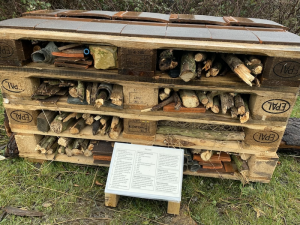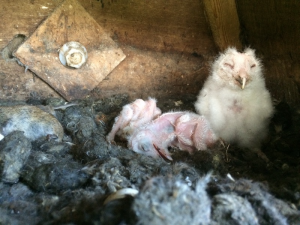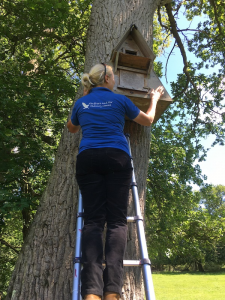Feathers and Fur Falconry Centre has British wildlife and conservation at the core of everything it does. Below are a number of ways that the falconers and volunteers work towards caring for and sharing our passion for the flora and fauna on our doorstep.
Teaching
Feathers and Fur Falconry Centre visits schools and groups with the Birds of Prey and Owls covering topics such as adaptation, habitats, predators, nocturnal birds, senses, and conservation. We introduce the children to the birds, allowing them to see up close the beauty of characters such as the Barn Owls and Kestrels. Feathers and Fur visits schools, WI, Scouts, Brownies, Beavers, Cubs, Rainbows, Environmental Groups, Church groups, and Social Groups. Click here for more details
Feathers and Fur Falconry also offers work experience placements to students from local agricultural colleges and those looking for work experience before heading to study veterinary or zoology courses.
Conservation and education on site
Feathers and Fur offers handling sessions and teaching sessions allowing people to get up close to our beautiful birds. Each of these sessions focuses heavily on the status of the birds in the wild, their adaptations and how we can help conserve them.
Our site also has lots of great facts and information boards about the Birds of Prey we have on site. Each aviary has an information board highlighting habitat, range, diet, lifespan, and population status.
To attract and help flora and fauna we have created a number of habitats in  our flying field along with information boards about each area for our customers to browse whilst up in the field. These habitats include a wild grass and slowworm area using corrugated sheeting for a warm area, log piles and buried logs for insects and beetles especially the Stag Beetle, a wildflower mound and a Buddleia plantation for Butterflies, Bat boxes and a pallet bug hotel, created with a variety of micro habitats for insects. We also allow scrub and long grass to grow around the edge of our field.
our flying field along with information boards about each area for our customers to browse whilst up in the field. These habitats include a wild grass and slowworm area using corrugated sheeting for a warm area, log piles and buried logs for insects and beetles especially the Stag Beetle, a wildflower mound and a Buddleia plantation for Butterflies, Bat boxes and a pallet bug hotel, created with a variety of micro habitats for insects. We also allow scrub and long grass to grow around the edge of our field.
We offer free advice on bird rescue, putting up raptor and owls boxes, and habitat management.
Volunteering and off site projects

Feathers and Fur Falconry Centre has placed a number of Barn Owl, and Kestrel boxes in the Reading area where Barn Owls and Kestrels have been sighted. These are currently monitored by Sadie Shepherd and Dr Matt Stevens from the Hawk Conservancy. The future intention is to place boxes in the Warfield and Bracknell area to extend this project, working alongside the British Owl Project with the main aim to then use these boxes to allow local schools to follow annually in their use and importance.
Sadie Shepherd, Feathers and Fur Falconry Centre owner has been, for the past 4 years, an Accredited Agent under Mrs Catherine McEwan for a Barn Owl Licence in order to voluntary inspect and record Barn Owl boxes in the Reading area. This information is collected as part of the West Berkshire Conservation Society Barn Owl Group. This data is then fed back to the BTO.

Feathers and Fur Falconry Centre have teamed up with the British Owl Project run by Louise Barton, to monitor owl populations in the Berkshire and Oxfordshire area ready for habitat work. This partnership will also include BOP and Feathers and Fur Falconry offering, hosting and teaching courses on wild Owl populations, biology, habitats and management, use of pesticides and the implications, handling of Owls, and conservation.

Sadie Shepherd also volunteers with a conservation group The Sonning Barn Owl box project in Sonning, Berkshire and works along side Colin Shawyer and Alastair Driver to monitor their Barn Owl, Tawny and Little Owl boxes.
Feathers and Fur Falconry Centre have also worked alongside Dr Matt Stevens and the Hawk Conservancy carrying out transect walks to monitor and record the numbers of Birds of Prey in specific areas.
As well as the above staff and volunteers also volunteer for organisations  such as Berkshire, Buckinghamshire, Oxfordshire Wildlife Trust and Wild Maidenhead conservation group, the Hawk Conservancy and Binfield Badger Group. This helps to expand our knowledge and helps to be part of the conservation we love to teach about.
such as Berkshire, Buckinghamshire, Oxfordshire Wildlife Trust and Wild Maidenhead conservation group, the Hawk Conservancy and Binfield Badger Group. This helps to expand our knowledge and helps to be part of the conservation we love to teach about.
